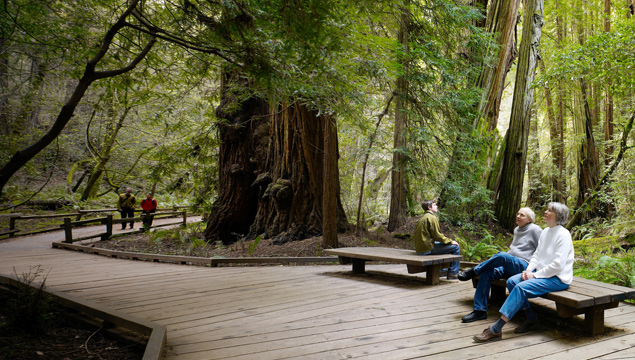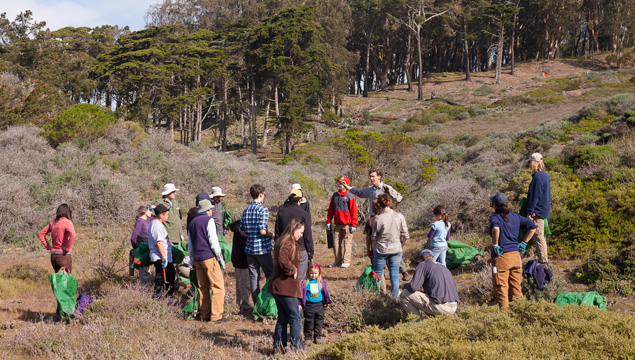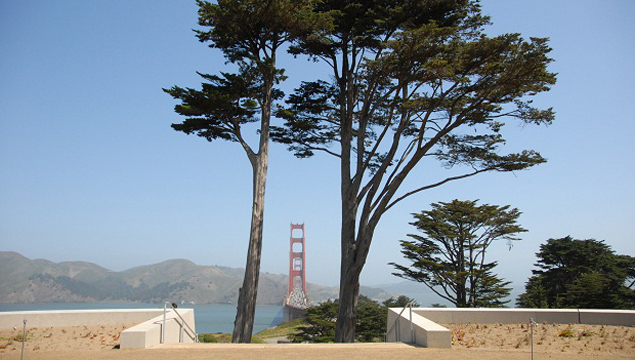Saving Nature in a Humanized World
Balancing history and ecology is difficult and delicate, especially at San Francisco’s Presidio, which contains one of the nation’s richest collections of cultural landscapes. How do its stewards manage the issues and the constituencies? How do they build consensus and resolve controversies? These are some of the issues to be covered in Bridging the Nature-Culture Divide III: Saving Nature in a Humanized World.

The Muir Woods, photo courtesy of Golden Gate National Parks Conservancy
Presented by TCLF and the Presidio Trust in partnership with the National Park Service (NPS) and the Golden Gate National Parks Conservancy, the three-day event (January 22-24, 2015) comprises a full-day symposium and tours of significant cultural landscapes in San Francisco’s Golden Gate National Recreation Area (GGNRA).
Sitting at the center of more than 80,000 acres of natural and designed landscapes, the Presidio is rich in history. Fortified as a Spanish military base in 1776, occupied by Mexican troops, and eventually seized by the US military in 1846, the site was designated a National Historic Landmark District in 1962 and transferred to the National Park Service in 1994. Amidst historic buildings and neatly landscaped grounds, the Presidio frames remarkable views and a compelling social history. Encompassing 130 miles of trails and 37 distinct sites, the surrounding GGNRA is one of the world’s largest urban parks in the world, hosting more than 16 million visitors each year. Despite post-War development and rapid urbanization of the Bay Area, the GGNRA is home to a significant number of threatened and endangered species, and designated by UNESCO a “biodiversity hotspot."
About 10% of the Presidio’s land preserves pre-settlement ecology, a development Michael Boland, Chief Planning, Projects, and Programs Officer of the Presidio Trust and Bridging the Nature-Culture Divide speaker, suggests was inadvertently caused by the military. These natural areas accommodate an astonishing biodiversity composed of thirteen native plant communities, 400 native plant species, and 300 bird species. Over the past twenty years the Presidio Trust, NPS, and the Golden Gate National Parks Conservancy have worked with thousands of volunteers to preserve and expand the biodiversity of the area while simultaneously helping the Presidio community achieve financial sustainability. Peter Del Tredici, Associate Professor at the Harvard Graduate School of Design, elaborates on the notion of pre-settlement ecology in the Bay Area (and everywhere) by asking us to challenge the rigid categorization of organisms as either native or non-native as, given the nuances of climate change and globalization, this has lost its efficacy as a tool for managing ecological change. As so-called feral ecology provided the vegetative foundation for the highly successful High Line in Manhattan, we might elsewhere begin to focus on the plants that grow spontaneously in urban areas and their remarkable ability to flourish in spite of stressful environmental conditions.

Photo © Tom Fox
Geoff Cape, Founder and CEO of Toronto-based community environmental center Evergreen Brickworks will describe recent efforts to integrate nature into Canada’s urban spaces. For Cape, activities such as urban agriculture, the daylighting of channelized rivers, and the restoration of natural landscapes from industrial ones is key to the revitalization of communities. Robin Grossinger, Senior Scientist at the San Francisco Estuary Institute has studied an inherent contradiction that exists in many urban environments: Often located in biodiversity hotspots on rivers or estuaries, cities are at once destructive to and supportive of native species. Though it can be challenging to envision cities as functional landscapes operating to support resilient ecosystems, it is possible to develop locally specific frameworks that enable diverse management activities that shape and maintain urban landscapes to achieve ecosystem resilience. Building upon this concept, Director of the Institute at the Golden Gate Chris Spence asserts that people are not just part of the problem; they are also the key to addressing issues of land management and conservation. At the conference, Spence will elaborate: In this time of rapid technological, social, economic, and demographic change, if landscape professionals are to be successful, they must develop communication strategies.
And public engagement is, without a doubt, one of the most important aspects of bridging the nature-culture divide. Jane Wolff, Associate Professor at University of Toronto, explores the hybridized Bay landscape in her recent work Bay Lexicon. By defining a vocabulary to describe landscape observations and interactions, Wolff will attempt to reveal and dissolve the flexible, often misunderstood boundaries between ecological and cultural zones. Drawing upon her role as Director of Education and Curator of Public Practice at the Walker Art Center in Minneapolis, Sarah Schultz will discuss dynamic approaches to exploring our complex personal and collective relationships to the natural world. You can read much more about the conference and all of the presenters here.
Beyond the conference on Friday January 23, the event also provides a number of unique opportunities to engage with Bay Area landscapes. A launch event on Thursday includes a sunset ferry ride to Alcatraz Island for a private visit to the site-specific @Large: Ai Weiwei on Alcatraz exhibit. Through seven large-scale mixed-media, sound, and sculptural installations, the exhibition grants access to many parts of the former penitentiary that are normally off-limits and provides a new look at the complex history of the island. Following the conference, Saturday offers a multitude of guided opportunities to explore the Presidio. Three walking tours and one motorcoach excursion will provide exclusive access to the area while addressing issues of resource management while calling upon the discussions of the previous day.
Held in 2011 at the Jay Heritage Center in New York, the first Nature-Culture event focused on building consensus through informed stewardship. A year later, the second in the series brought attention to the restoration and management of woodlands in New York City’s Central Park. Presented to a packed house, the symposium was recorded and more than five hours of archived footage is now available for viewing. This year Bridging the Nature-Culture Divide III will extend the series to the opposite side of the country while addressing issues that are relevant to the planet. This not-to-be-missed event, which will build on previous symposia, will provide new insights and thoughtful discussions about significant issues that are relevant to all of us. Registrations are still open but are filling up fast.

Golden Gate Overlook, photo courtesy of The Presidio Trust



